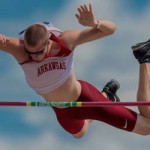
Former Razorback Tyson Gay couldn’t join the senior national team, but he did meet with future American stars.

Track aficionados who watched the sport’s world championships last week in Moscow were sure to notice two glaring omissions: Tyson Gay and Veronica Campbell-Brown – the latter is the most decorated Olympic athlete affiliated with the state of Arkansas. The former Razorbacks were shoe-ins to compete in the IAAF World Championships but were both waylaid in recent months by positive banned substance tests. Gay’s absence, in particular, has hurt the sport’s appeal in the United States. After a couple years of nagging injuries the 31-year-old had regained his health and looked ready to challenge world record holder Usain Bolt after running a 9.75 100 meter sprint and 19.74 200 meter sprint.
Instead, like the rest of us, he was relegated to watching Bolt win both events in Moscow – the 100s in 9.77 seconds, and the 200s in 19.66.
The absences of Gay and Campbell-Brown, along with a few other elite sprinters who recently tested positive for banned substances, have sparked plenty headlines leading up to these world championships. What has gone far less noticed – to the point where it hardly seems remarkable to many observers anymore – is the near total absence of elite sprinters without West African ancestry.
Before 2010, 70 of the 71 sprinters who’d run 100 meters in less than 10 seconds had primarily West African ancestry. That streak started when south Arkansas native Jim Hines first broke the 10-second barrier in the 1968 Olympics. Why do people with West African backgrounds – whether from the United States, the Caribbean or elsewhere – dominate sprinting?
This is one of the major questions tackled in the recently released “The Sports Gene: Inside the Science of Extraordinary Athletic Performance.” Its author, Sports Illustrated writer David Epstein, surveys a variety of scientific studies and adroitly weaves their results into layered narratives to make this book a must-have for anybody with a shred of interest in exercise genetics.
****
On the black-sprinters question, there’s predictably a vast assortment of nature AND nurture factors playing a role. Jamaica has a youth track culture, for
instance, that is just as strong as Texas’ or Arkansas’ youth football culture. A 6’4” blazing fast athlete the caliber of Usain Bolt was steered to track as his primary sport in in the Caribbean, but in the U.S. coaches likely would have told him his future was at wide receiver as the next Randy Moss.
On the nature side, Epstein touches on and unravels a few contributing factors:
1. “The Speed Gene”
Yes, there kind of is one.
But to understand how it works, you first have to know the explosive, “fast-twitch” muscle fibers which all elite sprinters have a lot of contain a structural protein called alpha-actinin-3. There are two versions of the ACTN3 gene that codes for this stuff.
One version – the X variant – has a genetic “stop sign” that stops production of the protein. Another version – the R variant of ACTN3 – functions normally and facilitates production of the protein. Each person inherits either an XX, RX or RR combination from their two parents. If you have an “XX” combination, you’re pretty much not going to be an elite sprinter no matter how hard you train, according to Epstein. These variants are found in different ethnic groups in varying proportions.
According to one study cited in “The Sports Gene,”a quarter of people of East Asian descent had two copies of the X variant. About 18 percent of white Australians had two X variants. But, it turns out, every sub-Saharan African population has only less than 1 percent have two X variants. This means there are far, far fewer people of African ethnicity who lack an R variant for explosive, fast-twitch muscle fibers.
Since studies confirm the best sprinters do NOT have the XX combination, we see how a large chunk of people on every continent immediately lose any realistic hope of being able to train for the Olympics – except on Africa. Conversely, people of African heritage will have a proportionally greater chance of having a couple of the right genetic ingredients to be really, really fast.
It is generally agreed Homo sapiens originally evolved in Africa, and then bands of people migrated to other continents. So why was it a good idea – in evolutionary terms – for the X variant for slow-twitch muscles to ever exist in the first place?
One theory holds the X version of ACTN3 proliferated during the last ice age. As Epstein writes: “Absence of alpha-actinin-3 may make fast-twitch muscle fibers more metabolically efficient, like their slow-twitch neighbors, a boon, perhaps, in frigid, food-scarce northern latitudes outside of Africa.”
Anthropologists also suggest the X version might have spread in the communities outside of Africa which evolved from a hunter-gatherer lifestyle to one dependent on agriculture. The men in such communities would have “less need to sprint in war or hunting but more need to be metabolically efficient and to work at a steady rate for long hours.”
Here’s an eagerly awaited showdown Gay was able to make.
2. Navel Raising
In 2010, a racially diverse research team from Duke and Howard universities reported black adults, compared to white adults, have a center of mass (approximately where the belly button is) that is about 3 percent higher.
This matters in sports performance.
The researchers determined the 3 percent difference translated into a 1.5 percent running speed advantage “for athletes with the higher belly buttons (i.e., black athletes) and a 1.5 percent swimming speed advantage for athletes with a lower belly button (i.e., white athletes),” as Epstein wrote.
(It also noted in the “The Sports Gene” that scientists who conducted this study were extremely reticent to avoid racial stereotyping, and preferring to use descriptions of body types instead of labeling people by race. “Our study does not advance the notion of race,” they wrote.)
3. Malaria’s Legacy
Almost all elite sprinters have ancestry in a specific region of Africa – the western part, in the lowlands of Ghana, Ivory Coast, Benin, Togo, Nigeria, Cameroon and other nations extending to the middle of the continent. Much of these areas are thick with swamps and jungle, which have for millenia served as bastions for mosquitoes and the malaria parasite they often carry.
These parasites infect the red blood cells of its host and spread through the person’s body using these oxygen-carrying cells as vectors. As a countermeasure, many west Africans evolved a gene variant that triggers their red blood cells to thin out in the shape of a sickle when infected by malaria parasitea. This prevents the parasite from spreading and protects the host.
This sickle cell trait also rears its head during sports which require high aerobic output and great stamina. The trait developed from a mutation found in one of two copies of the gene that codes for hemoglobin – the oxygen-carrying molecule in red blood cells. The mutation causes red blood cells to curl up in the shape of sickle in the absence of oxygen, and the resulting cells could clump. This, Epstein points out, potentially impairs blood flow through the body during vigorous exercise.
Here’s a major reason why African-Americans have been found to have lower hemoglobin levels at every stage of life than white Americans, even when socioeconomic status and nutrition are matched, according to studies cited in “The Sports Gene.” It is also a reason why there are few elite marathon runners of western/central African heritage. High oxygen-carrying capacity, a necessity of endurance sports, is a feature missing in a higher percentage of people of that heritage than most any other population.
Sickle cell gene mutation and the reduced hemoglobin it can cause cut down on the body’s ability to derive energy from pathways that depend on oxygen. However, there are other metabolic pathways, and Esptein writes about a few scientists who have linked dependence on some of those other pathways to a higher proportion of fast-twitch muscle fibers.
A 1986 study from Laval University in Quebec involved muscle samples taken from the thighs of 24 sedentary Laval students, primarily from West Africa countries, and 24 sedentary white Laval students.
The researchers reported a “a higher proportion of muscle in the African students was composed of fast-twitch muscle fibers, and a lower proportion was slow-twitch muscle fibers compared with the white students. The African students also had significantly higher activity in the metabolic pathways that rely less on oxygen to create energy and that are engaged during an all-out sprint.”
****
On the other side of Africa, a different evolutionary story has played out. In East Africa, mosquito counts are low, elevations are high. Into these mountains migrated people from lower regions around the Nile River, who had developed long, thin body types better for cooling in hot and dry climates.
It is this “Nilotic” body type – and, specifically, the proportionally longer and thinner limbs it entails – which provide a major reason why Kenyans, Ethiopians and Ugandans have come to dominate distance running events at the high levels.
Glance at the names of recent Little Rock Marathon male winners – Augustus Mbusya, Moninda Morube, Mark Chepses – and East Africans’ dominance in this arena immediately becomes clear.
Why are slender, long limbs such an advantage when running long distances?
Thinner legs – especially in the ankle area – mean less weight, which means a runner has to use less energy to swing that weight. And every extra bit of calf or ankle weight makes a runner less efficient. Indeed, Epstein cites research calculating that adding just one tenth of one pound to the ankle increases oxygen consumption during running by about 1 percent.
So a Kenyan, on the whole, will go faster for the same effort expended as, say, as a Dane or German.
One of the most important themes of Epstein’s book is that body types matter when it comes to competition. Some bodies are simply better suited for some events than others. Because of this, we can see someone with the build of a football player excel at sprinting events. Exhibit A is former Razorback cornerback Ahmad Carroll, who also ranks at the top of the UA track record book for the 55 meter and 60 meter sprints.
But we’ll never see someone with his muscular build topping the 3,000 or 5,000 meter lists.
That body types play a significant role in sports isn’t a bad or good thing. And it certainly isn’t racist. It’s simply how the world really is.
For the sake of space, I abbreviated much of Epstein’s writing on the athletic dominance of West and East African populations. I only provide one of the important reasons for Kenyan running dominance, but there are plenty of others. I highly encourage you to read – or listen – to “The Sports Gene” in its original format.
Former Arkansas Razorback distance runner Omar Abdi was the lone representative of the Somalia national team at the 2013 World Championships of track. He discusses his experience in this video from last week.
Demirel has more details from Epstein on Gay’s downfall here. Follow Demirel on Twitter.













